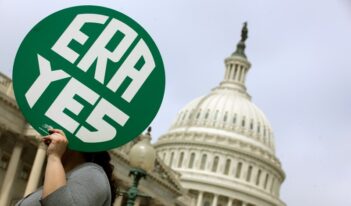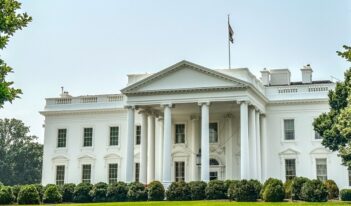
The Supreme Court’s approval of Ohio’s voting roll purge will limit voter turnout in future elections.
The election of President Donald Trump set in motion the aggressive rollback of Obama-era environmental regulations, healthcare provisions, and protections for LGBT individuals and immigrants. After nearly two years of the Trump presidency, Americans, and particularly the 40 percent who did not vote in 2016, may see clearly now that elections have consequences.
So too, do U.S. Supreme Court decisions, and the recent decision in Husted v. A. Philip Randolph Institute is an unfortunate case in point. In Husted, the Court upheld an Ohio law that is squarely aimed at knocking President Barack Obama’s winning coalition off the voter registration rolls. More than just reversing a single policy or regulation, Husted rolls back President Obama’s historic accomplishment of inspiring young people and communities of color to engage in the political process for the first time.
In the most recent term, the Court ruled that, under federal law, Ohio is permitted to begin a process of purging citizens from voter rolls if a person fails to vote in a midterm election. Under the pretense that a citizen’s failure to vote in a low turnout election indicates that the voter has moved, the state requires duly-registered Ohioans to send a letter to the state requesting that they maintain their voter registration status. The state has thus turned voting into a use-it-or-lose-it privilege, like coupons, credit card points, or airline miles with expiration dates, instead of a fundamental right that is protected by the Constitution and multiple hard-fought-for federal laws.
One such law, the National Voter Registration Act of 1993 (NVRA), regulates when and how states can remove ineligible voters from their voting rolls. One of the statute’s key provisions provides that states must take specific precautions before removing an individual who has possibly moved from the district. Another provision, called the “failure-to-vote clause,” explicitly prohibits states from removing an individual from voting rolls “by reason” of the individual’s failure to vote.
Yet Ohio—and the conservative majority in Husted—reasoned that the NVRA, as amended by the Help America Vote Act (HAVA), simply prohibits removing voters based solely on the person’s failure to vote and no additional factor. Justice Samuel Alito read HAVA to mean that a failure to vote in addition to some other indicator—including the absence of a response to a mailing—is valid grounds for removal. Settling on this interpretation, the Court majority ignored a key provision in HAVA that states that nothing in the statute “may be construed to authorize or require conduct prohibited under” the NVRA “or to supersede, restrict or limit the application” of the NVRA.
Under the state’s so-called supplemental process, Ohio’s policy assumes that individuals who fail to vote in a federal election have moved, unless they take deliberate action to reply to a mass mailing. Justice Alito, writing for the majority, avoided addressing the irrationality of this assumption by stating that the case only presented “a question of statutory interpretation, not a question of policy,” and that the Court had “no authority to second-guess Congress or to decide whether Ohio’s supplemental process is the ideal method for keeping its voting rolls up to date.”
In practice, Ohio used its supplemental process to identify 1.5 million registered voters as inactive in 2012—almost 20 percent of its 8 million registered voters. Ohio sent those 1.5 million registered voters confirmation notices. In response, Ohio received 60,000 cards that indicated, “Yes, I have moved,” and 235,000 that indicated, “No, I have not moved.” But over 1 million of the notices sent went unanswered. Ohio used the absence of a reply to start a clock and subsequently remove voters from the rolls unless they voted in the next two elections, even if nothing else indicated that the person had moved.
Beyond the fundamentally flawed presumption that individuals have moved away if they failed to vote, Ohio’s process disproportionately affects young, minority, and poor voters who are more likely to vote only in presidential elections. Many of these people are the voters who were inspired to vote for President Obama in 2012 but sat out in 2016.
The plaintiffs in Husted argued that Congress had specifically prohibited the sort of gamesmanship with voting rolls taking place in Ohio. They were right. The NVRA’s “failure-to-vote clause” clearly indicates that any state program designed to maintain voter rolls “shall not result in the removal of the name of any person from the official list of voters registered to vote in an election for federal office by reason of the person’s failure to vote.”
This majority’s opinion is contrary to the democratic principles underlying federal election law. As Justice Sonia Sotomayor wrote in her dissent in Husted, the explicit purpose of the NVRA was “to increase the registration and enhance the participation of eligible voters in federal elections.” With its over-inclusive process for identifying voters who have moved, Ohio’s law clearly was not designed to enhance participation of eligible voters.
Now, in the aftermath of Husted, Ohio voters who failed to vote in 2016 and who ignore the state’s “last chance” notice—as 80 percent of people do—could find themselves removed from the rolls in 2020. In the 2015 to 2016 period, Ohio purged 426,781 voters for failure to respond to the confirmation notice for voter inactivity. From 2011 to 2014, Ohio purged 846,391 voters for the same reason.
To see the political ramifications of Husted one need only look back to the 2008 election. We can see from the coalition that propelled President Barack Obama into the White House exactly which voters the GOP in Ohio and elsewhere is trying to keep off the rolls.
President Obama’s coalition established a path for the future not just of the Democratic Party—but perhaps the only genuine American majority for any political party. Generally, recent presidents have relied on narrow voting margins to win office: President Trump won by 80,000 votes in Michigan, Wisconsin, and Pennsylvania—combined. President George W. Bush won by a few hundred votes in Florida (or one vote in the Supreme Court). Even President William Clinton was elected in 1992 with only 43 percent of the popular vote due to third-party candidate Ross Perot. President Obama was the exception.
President Obama’s message lifted the spirits of occasional voters and motivated younger adults and individuals of color to turn out at the polls.
By contrast, the 2016 presidential campaign—largely an exchange of attack ads—dissuaded voters from engagement in the electoral system. Negative campaigns take a particular toll on those who have not yet developed voting as a civic habit and weaken the political voices of new communities, immigrant communities, and others who are systematically underrepresented in the democratic process. Voting laws like Ohio’s supplemental process are designed to clean up and reinforce the effects of negative campaigns built for voter suppression.
Thus, with Husted, the Supreme Court has now done more than just roll back statutory protections in the nation’s election law. It takes a step toward making sure a coalition like President Obama’s never makes it back to the polling booths.
The effects of Husted can be counteracted by a positive, inclusive process of enfranchising citizens for which there is far more room to grow. But this is not a partisan issue. Even in the deepest blue states, primary elections are scheduled and designed to protect entrenched incumbents at the cost of engaging and enfranchising the future of the party.
States should design their own positive supplemental processes: proactive efforts that reach out to communities who are eligible but less likely to vote—young people, communities of color, and immigrant communities, multi-language, college, and high school students—to encourage, educate, and enfranchise the exercise of their newly-gained rights. These positive efforts should encourage voting by Asian American, Latinx, and young people, who are less likely to vote than other groups are. If a voter does miss a vote in a midterm election, the state could inform the voter of the policy consequences enacted since that election, or inform them of the availability of absentee ballots, early voting, or other options for the next election. Such a program would be truly in line with the goals of the NVRA and would protect the legitimacy of American democracy.
This essay is part of a series, entitled The Supreme Court’s 2017–2018 Regulatory Term.




